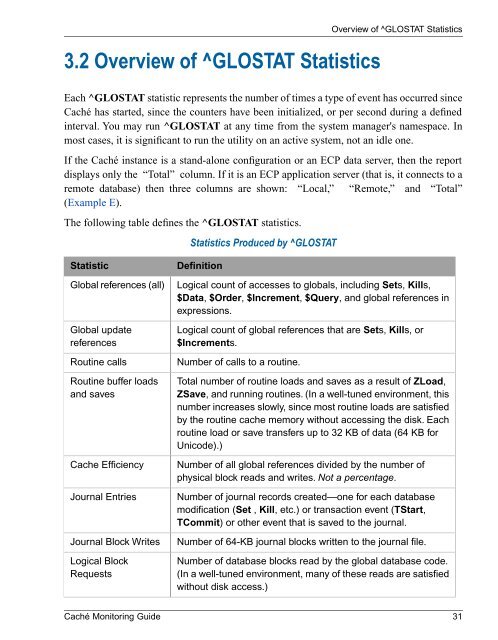Caché Monitoring Guide - InterSystems Documentation
Caché Monitoring Guide - InterSystems Documentation
Caché Monitoring Guide - InterSystems Documentation
Create successful ePaper yourself
Turn your PDF publications into a flip-book with our unique Google optimized e-Paper software.
3.2 Overview of ^GLOSTAT StatisticsEach ^GLOSTAT statistic represents the number of times a type of event has occurred since<strong>Caché</strong> has started, since the counters have been initialized, or per second during a definedinterval. You may run ^GLOSTAT at any time from the system manager's namespace. Inmost cases, it is significant to run the utility on an active system, not an idle one.If the <strong>Caché</strong> instance is a stand-alone configuration or an ECP data server, then the reportdisplays only the “Total” column. If it is an ECP application server (that is, it connects to aremote database) then three columns are shown: “Local,” “Remote,” and “Total”(Example E).The following table defines the ^GLOSTAT statistics.Statistics Produced by ^GLOSTATOverview of ^GLOSTAT StatisticsStatisticGlobal references (all)Global updatereferencesRoutine callsRoutine buffer loadsand savesCache EfficiencyJournal EntriesJournal Block WritesLogical BlockRequestsDefinitionLogical count of accesses to globals, including Sets, Kills,$Data, $Order, $Increment, $Query, and global references inexpressions.Logical count of global references that are Sets, Kills, or$Increments.Number of calls to a routine.Total number of routine loads and saves as a result of ZLoad,ZSave, and running routines. (In a well-tuned environment, thisnumber increases slowly, since most routine loads are satisfiedby the routine cache memory without accessing the disk. Eachroutine load or save transfers up to 32 KB of data (64 KB forUnicode).)Number of all global references divided by the number ofphysical block reads and writes. Not a percentage.Number of journal records created—one for each databasemodification (Set , Kill, etc.) or transaction event (TStart,TCommit) or other event that is saved to the journal.Number of 64-KB journal blocks written to the journal file.Number of database blocks read by the global database code.(In a well-tuned environment, many of these reads are satisfiedwithout disk access.)<strong>Caché</strong> <strong>Monitoring</strong> <strong>Guide</strong> 31
















